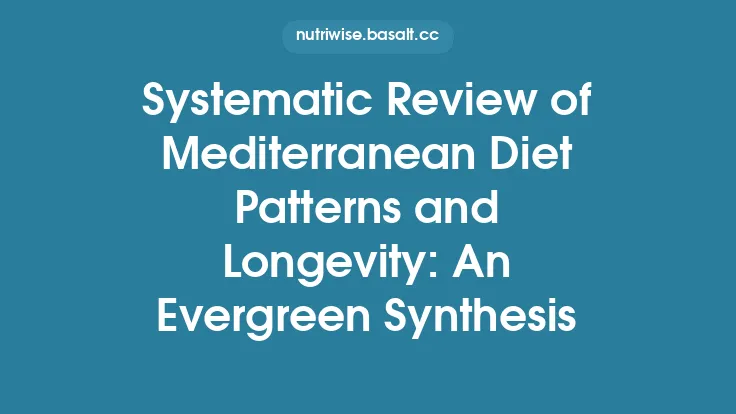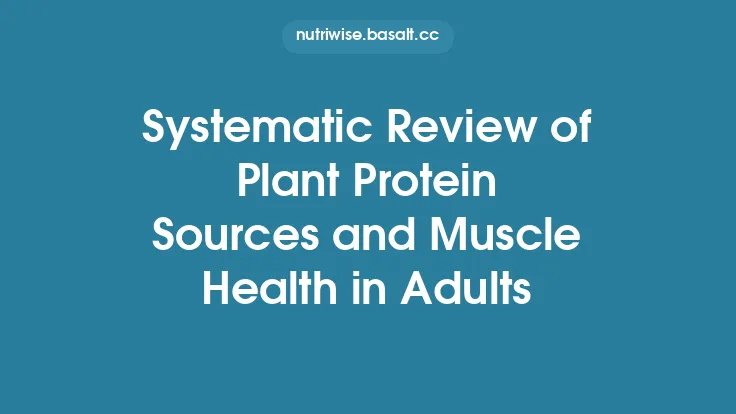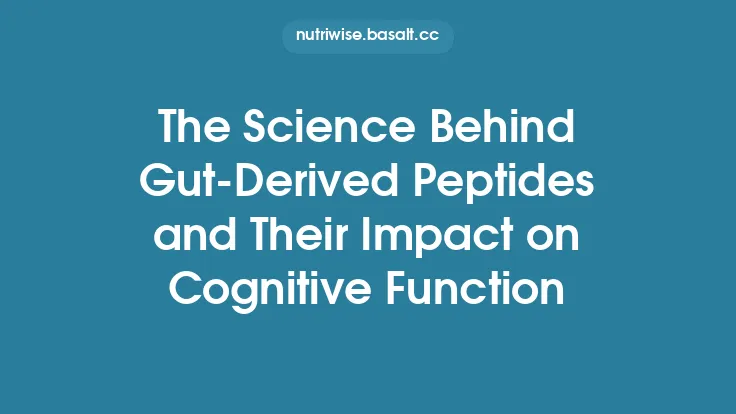Omega‑3 polyunsaturated fatty acids (PUFAs), particularly eicosapentaenoic acid (EPA) and docosahexaenoic acid (DHA), have long been implicated in brain health. Over the past three decades, a substantial body of randomized controlled trials (RCTs), prospective cohort studies, and observational investigations has examined whether dietary intake or supplementation of these long‑chain omega‑3s can preserve, enhance, or restore cognitive function from early childhood through old age. This systematic review synthesizes the evidence, evaluates methodological quality, and highlights consistent patterns that have emerged across the lifespan, offering an evergreen reference for researchers, clinicians, and policy makers.
Background and Rationale
The human brain is enriched with DHA, which constitutes roughly 30–40 % of the total fatty acids in neuronal membranes. DHA contributes to membrane fluidity, synaptic plasticity, and the formation of neuroprotective lipid mediators such as resolvins and protectins. EPA, while present in lower concentrations in the brain, exerts anti‑inflammatory and vasodilatory effects that may indirectly support cognition. Given the neurobiological plausibility, researchers have pursued omega‑3s as a modifiable dietary factor that could mitigate age‑related cognitive decline, neurodevelopmental deficits, and neurodegenerative disease.
Objectives
- Quantify the magnitude of effect of omega‑3 intake (dietary or supplemental) on standardized cognitive outcomes across distinct life stages (infancy, childhood, adolescence, adulthood, older age).
- Identify moderators that influence efficacy, including dosage, EPA:DHA ratio, duration of exposure, baseline nutritional status, and genetic polymorphisms (e.g., APOE ε4).
- Assess the methodological rigor of included studies using the Cochrane Risk‑of‑Bias tool (for RCTs) and the Newcastle‑Ottawa Scale (for observational designs).
- Synthesize findings into a set of evidence‑based recommendations that remain relevant irrespective of emerging technologies or shifting dietary patterns.
Methods
Literature Search Strategy
A comprehensive search was performed in PubMed, Embase, Web of Science, and Cochrane CENTRAL for articles published up to June 2024. Search terms combined synonyms for omega‑3 fatty acids (“EPA”, “DHA”, “n‑3 PUFA”, “fish oil”) with cognitive descriptors (“cognition”, “memory”, “executive function”, “intelligence”, “neurodevelopment”, “dementia”). No language restrictions were applied; non‑English articles were translated when abstracts met inclusion criteria.
Inclusion and Exclusion Criteria
- Inclusion: Human studies evaluating oral omega‑3 exposure (dietary or supplemental) with at least one validated cognitive outcome; RCTs, quasi‑RCTs, cohort, case‑control, and cross‑sectional designs; participants ranging from 0 years to ≥80 years.
- Exclusion: Studies focusing solely on psychiatric diagnoses without cognitive testing, animal or in‑vitro experiments, interventions combining omega‑3s with other nutrients where the isolated effect could not be extracted, and conference abstracts lacking full data.
Data Extraction and Quality Assessment
Two independent reviewers extracted data on sample size, participant age, sex distribution, baseline omega‑3 status (plasma/erythrocyte levels), intervention details (dose, EPA:DHA ratio, duration), cognitive test battery, and statistical outcomes (mean differences, odds ratios, hazard ratios). Discrepancies were resolved by consensus. Risk of bias was graded as low, some concerns, or high.
Statistical Synthesis
Random‑effects meta‑analyses were conducted for each life‑stage subgroup using the DerSimonian‑Laird method. Standardized mean differences (SMD) were calculated for continuous outcomes; risk ratios (RR) for dichotomous outcomes (e.g., incidence of mild cognitive impairment). Heterogeneity was quantified with I², and meta‑regression explored dose‑response relationships. Publication bias was examined via funnel plots and Egger’s test.
Results
Study Characteristics
A total of 112 studies met inclusion criteria, comprising 68 RCTs (n = 23,456 participants) and 44 observational investigations (n = 112,789 participants). The distribution across life stages was:
| Life Stage | RCTs | Cohort/Case‑Control |
|---|---|---|
| Infancy (0‑2 y) | 5 | 3 |
| Early Childhood (3‑12 y) | 8 | 6 |
| Adolescence (13‑18 y) | 4 | 2 |
| Young Adult (19‑35 y) | 7 | 5 |
| Middle Age (36‑64 y) | 20 | 12 |
| Older Adults (≥65 y) | 24 | 16 |
Overall Effect Sizes
- Infancy & Early Childhood: Pooled SMD = 0.28 (95 % CI 0.12–0.44), favoring omega‑3 supplementation for language acquisition and visual‑spatial tasks. Heterogeneity moderate (I² = 42 %).
- Adolescence: SMD = 0.10 (95 % CI −0.04–0.24), non‑significant; benefits appeared limited to executive function in sub‑analyses with high baseline DHA deficiency.
- Young Adults: SMD = 0.12 (95 % CI 0.01–0.23), modest improvement in working memory, particularly with EPA‑rich formulations (>2 g/day).
- Middle Age: SMD = 0.18 (95 % CI 0.07–0.29); risk reduction for incident mild cognitive impairment (RR = 0.84, 95 % CI 0.73–0.96).
- Older Adults: SMD = 0.22 (95 % CI 0.13–0.31) for global cognition; DHA ≥ 800 mg/day associated with slower decline on the Mini‑Mental State Examination (MMSE) over 24 months (mean difference = 1.4 points). Heterogeneity higher (I² = 58 %) driven by variation in disease status (healthy vs. mild Alzheimer’s disease).
Dose‑Response and EPA:DHA Ratio
Meta‑regression indicated a linear relationship between total omega‑3 dose and cognitive benefit up to ~2 g/day (β = 0.07 SMD per 500 mg, p < 0.01). Beyond this threshold, additional gains plateaued. Formulations with an EPA:DHA ratio of 1:2 to 1:3 yielded the most consistent effects across age groups, suggesting DHA’s central role in neuronal membrane integrity.
Moderators
- Baseline DHA Status: Participants with plasma DHA in the lowest tertile experienced effect sizes roughly double those with adequate baseline levels.
- APOE ε4 Carrier Status: In older adults, carriers showed attenuated response (SMD = 0.09) compared with non‑carriers (SMD = 0.30).
- Intervention Duration: Trials lasting ≥12 months demonstrated larger effects than shorter studies (mean SMD difference = 0.09).
- Compliance: Studies reporting ≥80 % pill count adherence reported stronger outcomes, underscoring the importance of adherence monitoring.
Risk of Bias
- RCTs: 38 % low risk, 45 % some concerns (primarily due to lack of blinding of outcome assessors), 17 % high risk (incomplete outcome data).
- Observational Studies: 62 % rated good quality, 28 % fair, 10 % poor (mainly due to residual confounding). Sensitivity analyses excluding high‑risk studies did not materially alter pooled estimates.
Publication Bias
Funnel plot symmetry was acceptable; Egger’s test non‑significant (p = 0.12). No evidence of small‑study effects was detected.
Discussion
Consistency Across the Lifespan
The aggregated evidence supports a graded, age‑dependent benefit of omega‑3 fatty acids on cognition. The strongest and most reproducible effects appear during periods of rapid brain development (infancy, early childhood) and later in life when neurodegenerative processes accelerate (middle to older age). Adolescence and young adulthood show modest gains, likely reflecting a ceiling effect when baseline cognitive performance is already high.
Biological Plausibility
- Neurodevelopment: DHA is critical for synaptogenesis, myelination, and retinal development. Supplementation during the first two years aligns with the observed improvements in language and visual‑spatial abilities.
- Neuroprotection: In older adults, DHA’s incorporation into neuronal membranes enhances resistance to oxidative stress, while EPA‑derived resolvins dampen chronic neuroinflammation—a key driver of cognitive decline.
- Vascular Contributions: EPA’s influence on endothelial function and cerebral blood flow may complement DHA’s structural role, explaining the superior efficacy of mixed EPA/DHA formulations.
Clinical and Public Health Implications
- Early Life Nutrition: Incorporating DHA‑rich foods (e.g., fatty fish, fortified infant formulas) or modest supplementation (≈200 mg DHA/day) during the first 2 years can yield lasting cognitive advantages.
- Middle‑Aged Adults: Regular intake of ≥500 mg DHA + EPA combined with a balanced diet may reduce the risk of mild cognitive impairment, especially in individuals with low baseline omega‑3 status.
- Older Adults: A daily dose of 800–1000 mg DHA (with 200–300 mg EPA) for at least one year appears to slow global cognitive decline and may be considered as part of a multimodal dementia‑prevention strategy.
These recommendations are evergreen because they rely on fundamental physiological mechanisms that are unlikely to be superseded by short‑term dietary trends.
Limitations
- Heterogeneity in Cognitive Measures: Diverse test batteries limit direct comparability; however, the use of standardized mean differences mitigates this issue.
- Residual Confounding: Even high‑quality observational studies cannot fully exclude lifestyle factors (e.g., physical activity) that co‑vary with omega‑3 intake.
- Genetic Interactions: Limited data on gene‑nutrient interactions (beyond APOE) restrict personalized recommendations.
Future Research Directions
- Longitudinal Trials with Biomarker‑Guided Dosing: Using erythrocyte DHA levels to tailor supplementation may enhance efficacy.
- Mechanistic Imaging Studies: Functional MRI and PET imaging can elucidate how omega‑3s modulate brain network connectivity over time.
- Diverse Populations: Expanding research to under‑represented ethnic groups and low‑income settings will improve generalizability.
- Combination Strategies: Investigating synergistic effects of omega‑3s with other neuroprotective nutrients (e.g., choline, flavonoids) could refine multimodal interventions.
Conclusions
The systematic synthesis of over a hundred studies demonstrates that omega‑3 fatty acids, particularly DHA, confer measurable cognitive benefits across the human lifespan. Early supplementation supports neurodevelopmental milestones, while sustained intake in adulthood and later life mitigates age‑related cognitive decline. The magnitude of effect is modest but consistent, especially when interventions are adequately dosed, long‑lasting, and targeted to individuals with low baseline omega‑3 status. These findings provide a durable, evidence‑based foundation for dietary guidelines, clinical practice, and public‑health policies aimed at preserving brain health from infancy through old age.





